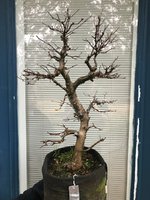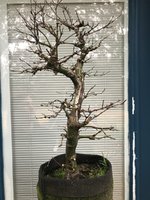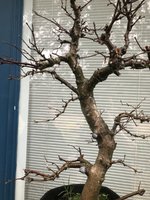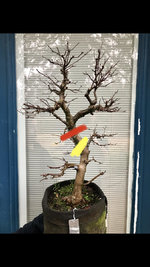jcasalva
Seedling
Hello everyone,
First post from me, although I've been lurker for a couple years now. I acquired this deshojo earlier this year (consistent with my ongoing mission to own all the deshojos in the world), and wanted to get some advice about potential air layer locations from different eyes. I posted a few pics of the tree from all four sides, as well as another pic of the front with what I am currently thinking for a potential air layer location (at red) and chop at yellow, with the new leader for the bottom half just at the branch to the right of yellow.
I did a fair amount of winter pruning last month, and my current plan is to do a full repot out of that soil into a pond basket this spring, let it strengthen up more, then in late spring of 2022 do the proposed layer. Alternatively, I could just leave it as is, but there is a pretty large scar in the pic of the back of the tree, and the scar has caused some minor-moderate reverse taper in that section of the trunk. Not as visible in the front pic, but I thought an air layer of the top to make a smaller triple trunk design would be more interesting than leaving it as is, then just use a new starter for the bottom half. Thanks for any help or suggestions!
First post from me, although I've been lurker for a couple years now. I acquired this deshojo earlier this year (consistent with my ongoing mission to own all the deshojos in the world), and wanted to get some advice about potential air layer locations from different eyes. I posted a few pics of the tree from all four sides, as well as another pic of the front with what I am currently thinking for a potential air layer location (at red) and chop at yellow, with the new leader for the bottom half just at the branch to the right of yellow.
I did a fair amount of winter pruning last month, and my current plan is to do a full repot out of that soil into a pond basket this spring, let it strengthen up more, then in late spring of 2022 do the proposed layer. Alternatively, I could just leave it as is, but there is a pretty large scar in the pic of the back of the tree, and the scar has caused some minor-moderate reverse taper in that section of the trunk. Not as visible in the front pic, but I thought an air layer of the top to make a smaller triple trunk design would be more interesting than leaving it as is, then just use a new starter for the bottom half. Thanks for any help or suggestions!






